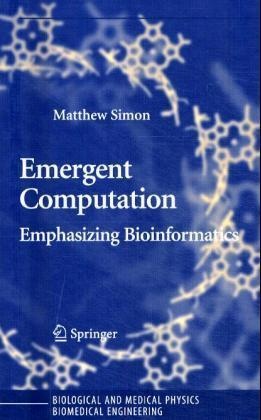Read more
Emergent Computation emphasizes the interrelationship of the different classes of languages studied in mathematical linguistics (regular, context-free, context-sensitive, and type 0) with aspects to the biochemistry of DNA, RNA, and proteins. In addition, aspects of sequential machines such as parity checking and semi-groups are extended to the study of the Biochemistry of DNA, RNA, and proteins. Mention is also made of the relationship of algebraic topology, knot theory, complex fields, quaternions, and universal turing machines and the biochemistry of DNA, RNA, and proteins.
Emergent Computation tries to avoid an emphasis upon mathematical abstraction ("elegance") at the expense of ignoring scientific facts known to Biochemists. Emergent Computation is based entirely upon papers published by scientists in well-known and respected professional journals. These papers are based upon current research. A few examples of what is not ignored to gain "elegance":
- DNA exists as triple and quadruple strands
- Watson-Crick complementary bases have mismatches
- There can be more than four bases in DNA
- There are more than sixty-four codons
- There may be more that twenty amino acids in proteins
While Emergent Computation emphasizes bioinformatics applications, the last chapter studies mathematical linguistics applied to areas such as languages found in birds, insects, medical applications, anthropology, etc.
Emergent Computation tries to avoid unnecessary mathematical abstraction while still being rigorous. The demands made upon the knowledge of chemistry or mathematics is minimized as well. The collected technical references are valuable in itself for additional reading.
List of contents
Part 1 : Automata Theory and the Biochemistry of Genetics; A Review of Chemistry; A Review of Automata Theory; The Beginning Numbers; Regular Languages: DNA and RNA; Context Free Languages: DNA and RNA; Context Sensitive Languages: DNA, RNA, Proteins; Turing Machines and SubTuring Machines; Splicing Systems, H Systems; tRNA Structure; Semigroups and BioInformatics.- Part II : Automata Theory and Disciplines Other Than Bioinformatics; Automata Theory: non-Bioinformatics Emergent Computation. Appendix. References. Index
Summary
Emergent Computation emphasizes the interrelationship of the different classes of languages studied in mathematical linguistics (regular, context-free, context-sensitive, and type 0) with aspects to the biochemistry of DNA, RNA, and proteins. In addition, aspects of sequential machines such as parity checking and semi-groups are extended to the study of the Biochemistry of DNA, RNA, and proteins. Mention is also made of the relationship of algebraic topology, knot theory, complex fields, quaternions, and universal turing machines and the biochemistry of DNA, RNA, and proteins.
Emergent Computation tries to avoid an emphasis upon mathematical abstraction ("elegance") at the expense of ignoring scientific facts known to Biochemists. Emergent Computation is based entirely upon papers published by scientists in well-known and respected professional journals. These papers are based upon current research. A few examples of what is not ignored to gain "elegance":
- DNA exists as triple and quadruple strands
- Watson-Crick complementary bases have mismatches
- There can be more than four bases in DNA
- There are more than sixty-four codons
- There may be more that twenty amino acids in proteins
While Emergent Computation emphasizes bioinformatics applications, the last chapter studies mathematical linguistics applied to areas such as languages found in birds, insects, medical applications, anthropology, etc.
Emergent Computation tries to avoid unnecessary mathematical abstraction while still being rigorous. The demands made upon the knowledge of chemistry or mathematics is minimized as well. The collected technical references are valuable in itself for additional reading.

